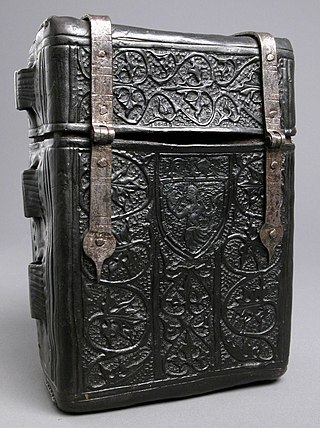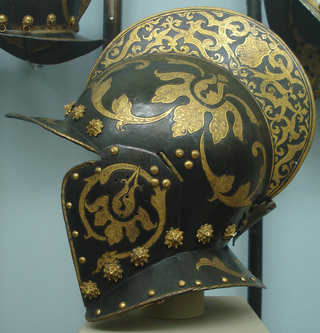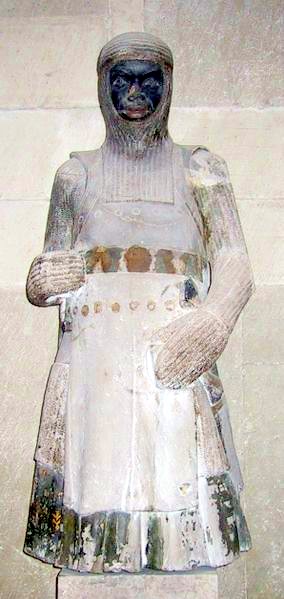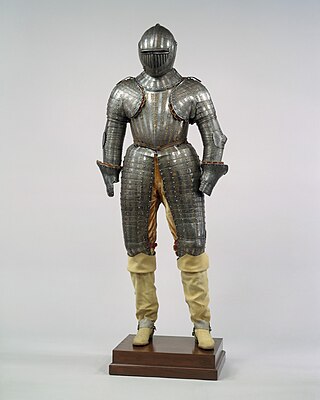
Boiled leather, often referred to by its French translation, cuir bouilli, was a historical material common in the Middle Ages and Early Modern Period and used for various purposes. It was leather that had been treated so that it became tough and rigid, as well as able to hold moulded decoration. It was the usual material for the robust carrying-cases that were made for important pieces of metalwork, instruments such as astrolabes, personal sets of cutlery, books, pens and the like. It was used for some armour, being both much cheaper and much lighter than plate armour, but could not withstand a direct blow from a blade, nor a gunshot.
A sword is an edged, bladed weapon intended for manual cutting or thrusting. Its blade, longer than a knife or dagger, is attached to a hilt and can be straight or curved. A thrusting sword tends to have a straighter blade with a pointed tip. A slashing sword is more likely to be curved and to have a sharpened cutting edge on one or both sides of the blade. Many swords are designed for both thrusting and slashing. The precise definition of a sword varies by historical epoch and geographic region.

Bocage is a terrain of mixed woodland and pasture characteristic of parts of northern France, southern England, Ireland, the Netherlands, northern Spain and northern Germany, in regions where pastoral farming is the dominant land use.

A cuirass is a piece of armour that covers the torso, formed of one or more pieces of metal or other rigid material. The word probably originates from the original material, leather, from the French cuirace and Latin word coriacea. The use of the term "cuirass" generally refers to both the breastplate and the backplate pieces; whereas a breastplate only protects the front, a cuirass protects both the front and the back of the wearer.

Plate armour is a historical type of personal body armour made from bronze, iron, or steel plates, culminating in the iconic suit of armour entirely encasing the wearer. Full plate steel armour developed in Europe during the Late Middle Ages, especially in the context of the Hundred Years' War, from the coat of plates worn over mail suits during the 14th century.

The bascinet – also bassinet, basinet, or bazineto – was a Medieval European open-faced combat helmet. It evolved from a type of iron or steel skullcap, but had a more pointed apex to the skull, and it extended downwards at the rear and sides to afford protection for the neck. A mail curtain was usually attached to the lower edge of the helmet to protect the throat, neck and shoulders. A visor was often employed from c. 1330 to protect the exposed face. Early in the fifteenth century, the camail began to be replaced by a plate metal gorget, giving rise to the so-called "great bascinet".

Kabuto is a type of helmet first used by ancient Japanese warriors that, in later periods, became an important part of the traditional Japanese armour worn by the samurai class and their retainers in feudal Japan.

A brigandine is a form of body armour from the Middle Ages. It is a garment typically made of heavy cloth, canvas, or leather, lined internally with small oblong steel plates riveted to the fabric, sometimes with a second layer of fabric on the inside.

The destrier is the best-known war horse of the Middle Ages. It carried knights in battles, tournaments, and jousts. It was described by contemporary sources as the Great Horse, due to its significance.

The burgonet helmet was a Renaissance-era and early modern combat helmet. It was the successor of the sallet.

The P 26/40 was an Italian World War II heavy tank. It was armed with a 75 mm gun and an 8 mm Breda machine gun, plus another optional machine gun in an anti-aircraft mount. Design had started in 1940 but very few had been built by the time Italy signed the armistice with the Allies in September 1943 and the few produced afterwards were used by the Germans.

Steven Joseph Zaloga is an American author and defense consultant. He received a bachelor's degree cum laude at Union College and a master's degree at Columbia University, both in history.

Lobster-tailed pot helmet, also known as the zischägge, horseman's pot and harquebusier's pot, was a type of combat helmet. It was derived from an Ottoman Turkish helmet type. From c. 1600, it became popular in most of Europe and was especially worn by cavalrymen and officers. The helmet gradually fell out of use in most of Europe in the late 17th century; however, the Austrian heavy cavalry retained it for some campaigns as late as the 1780s.
"Banded mail" is a neologism, coined in the 19th century, describing a type of composite armour formed by combining the concepts behind the Roman lorica segmentata with splint armour. Its historicity is doubtful. It has become entrenched in the popular consciousness as a result of its inclusion in the armour list for Dungeons & Dragons.

Charles John ffoulkes (1868–1947) was a British historian, and curator of the Royal Armouries at London. He was a younger son of the Reverend Edmund ffoulkes. He wrote extensively on medieval arms and armour.

A coat of plates is a form of segmented torso armour consisting of overlapping metal plates riveted inside a cloth or leather garment. The coat of plates is considered part of the era of transitional armour and was normally worn as part of a full knightly harness. The coat saw its introduction in Europe among the warring elite in the 1180s or 1220s and was well established by the 1250s. It was in very common usage by the 1290s. By the 1350s it was universal among infantry militias as well. After about 1340, the plates covering the chest were combined to form an early breastplate, replacing the coat of plates. After 1370, the breastplate covered the entire torso. Different forms of the coat of plates, known as the brigandine and jack of plates, remained in use until the late 16th century.
Gothic plate armour was the type of steel plate armour made in the Holy Roman Empire during the 15th century.

Munition armour was mass-produced armour stockpiled in armouries to equip both foot soldiers and mounted cuirassiers.

Laminar armour is an armour made from horizontal overlapping rows or bands of, usually small, solid armour plates called lames, as opposed to lamellar armour, which is made from individual armour scales laced together to form a solid-looking strip of armour. Prominent examples of such armour are lorica segmentata of Ancient Rome and certain versions of samurai armour.
The Inventory of Henry VIII compiled in 1547 is a list of the possessions of the crown, now in the British Library as Harley MS 1419.

















